Optimal Scheduling for Hybrid Battery Swapping System of Electric Vehicles
Abstract
1. Introduction
- Based on ICT technology, a framework of the hybrid battery swapping system (HBSS) is proposed. The cooperative operation of the MS and SS modes can significantly alleviate range anxiety;
- The swapping cost is introduced for EVs participating in the HBSS model. Based on this, a Sigmoid function is used to express the uncertainty of EVs’ selections;
- An optimal scheduling strategy, based on the swapping service fee, is established to achieve the highest operational efficiency of HBSS. The existence of the unique global optimal solution and the non-existence of the local optimal solution are proved mathematically.
2. Hybrid Battery Swapping System (HBSS) Model
- The whole scheduling horizon is divided into several time slots for analysis. This paper takes the scheduling horizon as one day and the time slot as half an hour;
- Without queuing, the battery swapping process is completed in one time slot.
3. Generation of Swapping Demand Scenario
4. HBSS Optimal Scheduling Strategy
4.1. Battery Swapping Process
- Rule 1: If the remaining battery power is not enough to reach the BSS when the EV generates the swapping demand, it will necessarily select the MS service. It ensures that EVs will not stop driving when the battery runs out, which is vital for alleviating range anxiety.
- Rule 2: Based on a positive in rule 1, if the detour distance is less than a certain threshold , the SS mode must be selected. This rule facilitates serving all BSVs to EVs with higher service values. Considering the extra service fee charged by the MS service, an EV with a small will prefer the SS mode.
4.2. Optimal Scheduling Strategy Considering Uncertainty
5. Numerical Simulations
5.1. Effectiveness Analysis of HBSS Optimal Scheduling Strategy
5.2. Impact Analysis of Key Factors on HBSS Operation
6. Conclusions
- The HBSS model can effectively alleviate range anxiety. The EVs that will run out of power can be accurately identified and served by MS services. The HBSS model can realize the cooperative operation of two battery swapping modes;
- The MS service fee has an important influence on the EV driver’s selection and utilization efficiency of battery swapping facilities. The queue length under the proposed strategy is reduced by 71.64% when compared with that under the fixed service fee;
- During the planning stage of the HBSS model, the maximum service capacity of both modes and the threshold in rule 2 must be carefully determined based on practical factors, including the investment scale and traffic topology. Since more EV drivers will still select the SS mode, SS service capacity should be increased and the threshold in rule 2 should be kept low.
Supplementary Materials
Author Contributions
Funding
Data Availability Statement
Conflicts of Interest
Nomenclature
| Shortest driving distance of EV i in MS/SS mode | |
| Shortest distance between origin-destination/origin-BSS/BSS-destination | |
| Detour distance of EV i | |
| Total number of EVs selecting MS/SS service at time t | |
| Number of EVs that actively select MS/SS service | |
| Number of EVs that passively select MS/SS service | |
| Number of queueing EVs in MS/SS mode | |
| Service fee of mobile swapping | |
| Parameters | |
| Number of EVs that generate swapping demand at time t | |
| SOC of EV i when generating swapping demand | |
| Remaining power when EV i reaches BSS | |
| Battery capacity | |
| S | Power consumption per 100 km |
| Shortest detour distance for EVs to accept MS service | |
| Maximum service capacity of MS/SS service | |
| Swapping cost of EV i | |
| Minimum/maximum service fee | |
| Lower bound of service fee set by the operators | |
| φ/ψ | Distance parameters used to calculate the minimum/maximum service fee |
| k | Ratio of the maximum service capacities |
| Acronyms | |
| EV | Electric vehicle |
| HBSS | Hybrid battery swapping system |
| MS | Mobile battery swapping |
| SS | Stationary battery swapping |
| BSM | Battery swapping mode |
| BCS | Battery charging station |
| DB | Depleted battery |
| FB | Full-charged battery |
| BSS | Battery swapping station |
| SOC | State of Charge |
| BSV | Battery swapping van |
| SSC | Swapping scheduling center |
| OD | Origin and destination |
Appendix A
- 1.
- 2.
- 3.
- and
References
- Liu, C.; Xu, D.; Weng, J.; Zhou, S.; Li, W.; Wan, Y.; Jiang, S.; Zhou, D.; Wang, J.; Huang, Q. Phase Change Materials Application in Battery Thermal Management System: A Review. Materials 2020, 13, 4622. [Google Scholar] [CrossRef] [PubMed]
- Wang, Z.; Hou, S. A real-time strategy for vehicle-to-station recommendation in battery swapping mode. Energy 2023, 272, 127154. [Google Scholar] [CrossRef]
- US Department of Energy. Volumetric Energy Density Of Lithium-Ion Batteries Increased By 8+ Times between 2008 & 2020. Available online: https://cleantechnica.com/2022/04/18/volumetric-energy-density-of-lithium-ion-batteries-increased-by-8-times-between-2008-2020/ (accessed on 8 May 2023).
- Yu, X.; Zhao, L.; Zhang, K.; Guo, H. A Shift Schedule to Optimize Pure Electric Vehicles Based on RL Using Q-Learning and Opt LHD. Processes 2022, 10, 2132. [Google Scholar] [CrossRef]
- Kabir, M.E.; Sorkhoh, I.; Moussa, B.; Assi, C. Joint Routing and Scheduling of Mobile Charging Infrastructure for V2V Energy Transfer. IEEE Trans. Intell. Veh. 2021, 6, 736–746. [Google Scholar] [CrossRef]
- Woo, S.; Bae, S.; Moura, S.J. Pareto optimality in cost and service quality for an Electric Vehicle charging facility. Appl. Energy 2021, 290, 116779. [Google Scholar] [CrossRef]
- Liu, X.; Soh, C.B.; Yao, S.; Zhang, H.; Zhao, T. Operation Management of Multiregion Battery Swapping–Charging Networks for Electrified Public Transportation Systems. IEEE Trans. Transp. Electrif. 2020, 6, 1013–1025. [Google Scholar] [CrossRef]
- Yan, J.; Menghwar, M.; Asghar, E.; Panjwani, M.K.; Liu, Y. Real-time energy management for a smart-community microgrid with battery swapping and renewables. Appl. Energy 2019, 238, 180–194. [Google Scholar] [CrossRef]
- Liang, Y.; Cai, H.; Zou, G. Configuration and system operation for battery swapping stations in Beijing. Energy 2021, 214, 118883. [Google Scholar] [CrossRef]
- Mehrjerdi, H. Resilience oriented vehicle-to-home operation based on battery swapping mechanism. Energy 2020, 218, 119528. [Google Scholar] [CrossRef]
- Zhang, F.; Yao, S.; Zeng, X.; Yang, P.; Zhao, Z.; Lai, C.S.; Lai, L.L. Operation Strategy for Electric Vehicle Battery Swap Station Cluster Participating in Frequency Regulation Service. Processes 2021, 9, 1513. [Google Scholar] [CrossRef]
- Zhang, X.; Peng, L.; Cao, Y.; Liu, S.; Zhou, H.; Huang, K. Towards holistic charging management for urban electric taxi via a hybrid deployment of battery charging and swap stations. Renew. Energy 2020, 155, 703–716. [Google Scholar] [CrossRef]
- Wang, X.; Wang, J.; Liu, J. Vehicle to Grid Frequency Regulation Capacity Optimal Scheduling for Battery Swapping Station Using Deep Q-Network. IEEE Trans. Ind. Inform. 2021, 17, 1342–1351. [Google Scholar] [CrossRef]
- Sautermeister, S.; Falk, M.; Baker, B.; Gauterin, F.; Vaillant, M. Influence of measurement and prediction uncertainties on range estimation for electric vehicles. IEEE Trans. Intell. Transp. Syst. 2018, 19, 2615–2626. [Google Scholar] [CrossRef]
- Babu, P.R.; Reddy, A.G.; Palaniswamy, B.; Kommuri, S.K. EV-Auth: Lightweight Authentication Protocol Suite for Dynamic Charging System of Electric Vehicles with Seamless Handover. IEEE Trans. Intell. Veh. 2022, 7, 734–747. [Google Scholar] [CrossRef]
- Raeesi, R.; Zografos, K.G. The electric vehicle routing problem with time windows and synchronised mobile battery swapping. Transp. Res. Part B Methodol. 2020, 140, 101–129. [Google Scholar] [CrossRef]
- Ferreira, J.C.; Monteiro, V.; Afonso, J.L. Vehicle-to-anything application (V2Anything App) for electric vehicles. IEEE Trans. Ind. Inform. 2014, 10, 1927–1937. [Google Scholar] [CrossRef]
- Sarrafan, K.; Muttaqi, K.M.; Sutanto, D.; Town, G.E. An Intelligent Driver Alerting System for Real-Time Range Indicator Embedded in Electric Vehicles. IEEE Trans. Ind. Appl. 2017, 53, 1751–1760. [Google Scholar] [CrossRef]
- Xu, M.; Yang, H.; Wang, S. Mitigate the range anxiety: Siting battery charging stations for electric vehicle drivers. Transp. Res. Part C Emerg. Technol. 2020, 114, 164–188. [Google Scholar] [CrossRef]
- Huang, S.; He, L.; Gu, Y.; Wood, K.; Benjaafar, S. Design of a Mobile Charging Service for Electric Vehicles in an Urban Environment. IEEE Trans. Intell. Transp. Syst. 2015, 16, 787–798. [Google Scholar] [CrossRef]
- Shao, S.; Guo, S.; Qiu, X. A Mobile Battery Swapping Service for Electric Vehicles Based on a Battery Swapping Van. Energies 2017, 10, 1667. [Google Scholar] [CrossRef]
- Zhou, J.; Yang, G.; Tang, G. The mathematical modeling of the mobile recharging facility vehicles’ scheduling and its genetic algorithm solution. In Proceedings of the 2015 IEEE International Conference on Cyber Technology in Automation, Control, and Intelligent Systems (CYBER), Shenyang, China, 8–12 June 2015; IEEE: Piscataway, NJ, USA, 2015; pp. 2040–2043. [Google Scholar] [CrossRef]
- Cao, Y.; Zhang, X.; Zhou, B.; Duan, X.; Tian, D.; Dai, X. MEC Intelligence Driven Electro-Mobility Management for Battery Switch Service. IEEE Trans. Intell. Transp. Syst. 2020, 22, 4016–4029. [Google Scholar] [CrossRef]
- Liu, H.; Wang, B.; Wang, N.; Wu, Q.; Yang, Y.; Wei, H.; Li, C. Enabling strategies of electric vehicles for under frequency load shedding. Appl. Energy 2018, 228, 843–851. [Google Scholar] [CrossRef]
- Sengor, I.; Guner, S.; Erdinc, O. Real-Time Algorithm Based Intelligent EV Parking Lot Charging Management Strategy Providing PLL Type Demand Response Program. IEEE Trans. Sustain. Energy 2021, 12, 1256–1264. [Google Scholar] [CrossRef]
- Liu, H.; Zhang, Y.; Ge, S.; Gu, C.; Li, F. Day-Ahead Scheduling for an Electric Vehicle PV-Based Battery Swapping Station Considering the Dual Uncertainties. IEEE Access 2019, 7, 115625–115636. [Google Scholar] [CrossRef]
- Li, Y.; Yang, Z.; Li, G.; Mu, Y.; Zhao, D.; Chen, C.; Shen, B. Optimal scheduling of isolated microgrid with an electric vehicle battery swapping station in multi-stakeholder scenarios: A bi-level programming approach via real-time pricing. Appl. Energy 2018, 232, 54–68. [Google Scholar] [CrossRef]
- Zhang, Y.; You, P.; Cai, L. Optimal Charging Scheduling by Pricing for EV Charging Station with Dual Charging Modes. IEEE Trans. Intell. Transp. Syst. 2019, 20, 3386–3396. [Google Scholar] [CrossRef]
- Zhao, Z.; Zhang, L.; Yang, M.; Chai, J.; Li, S. Pricing for private charging pile sharing considering EV consumers based on non-cooperative game model. J. Clean. Prod. 2020, 254, 120039. [Google Scholar] [CrossRef]
- Zeng, J.-Y.; Ou, H.; Tang, T.-Q. Feedback strategy with delay in a two-route traffic network. Phys. A Stat. Mech. Its Appl. 2019, 534, 122195. [Google Scholar] [CrossRef]
- Ge, X.; Shi, L.; Liu, Y.; Fu, Y.; Xia, S. Load Forecasting of Electric Vehicles Based on Sigmoid Cloud Model Considering the Uncertainty of Demand Response. Zhongguo Dianji Gongcheng Xuebao/Proc. Chin. Soc. Electr. Eng. 2020, 40, 6913–6924. [Google Scholar] [CrossRef]
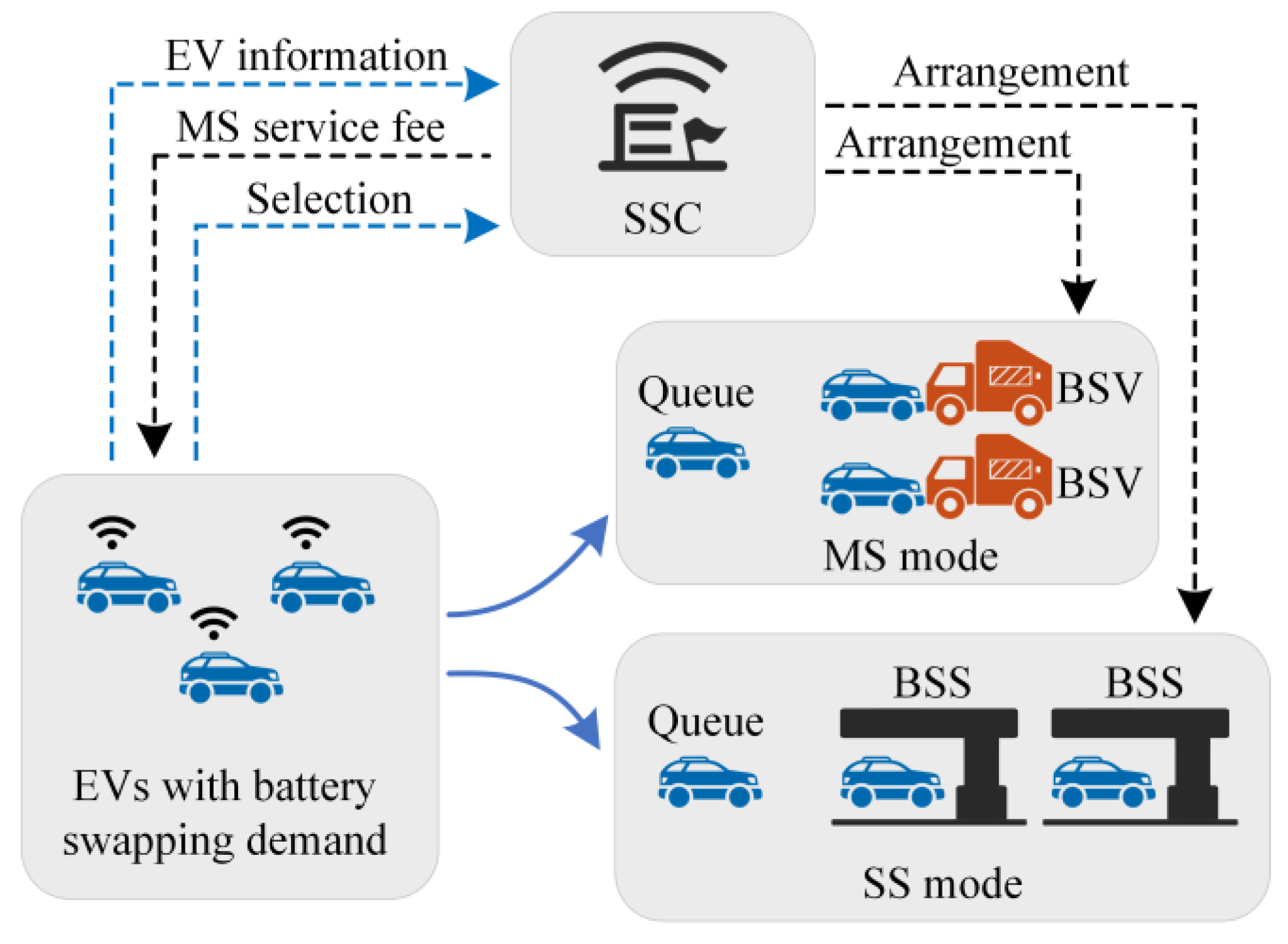


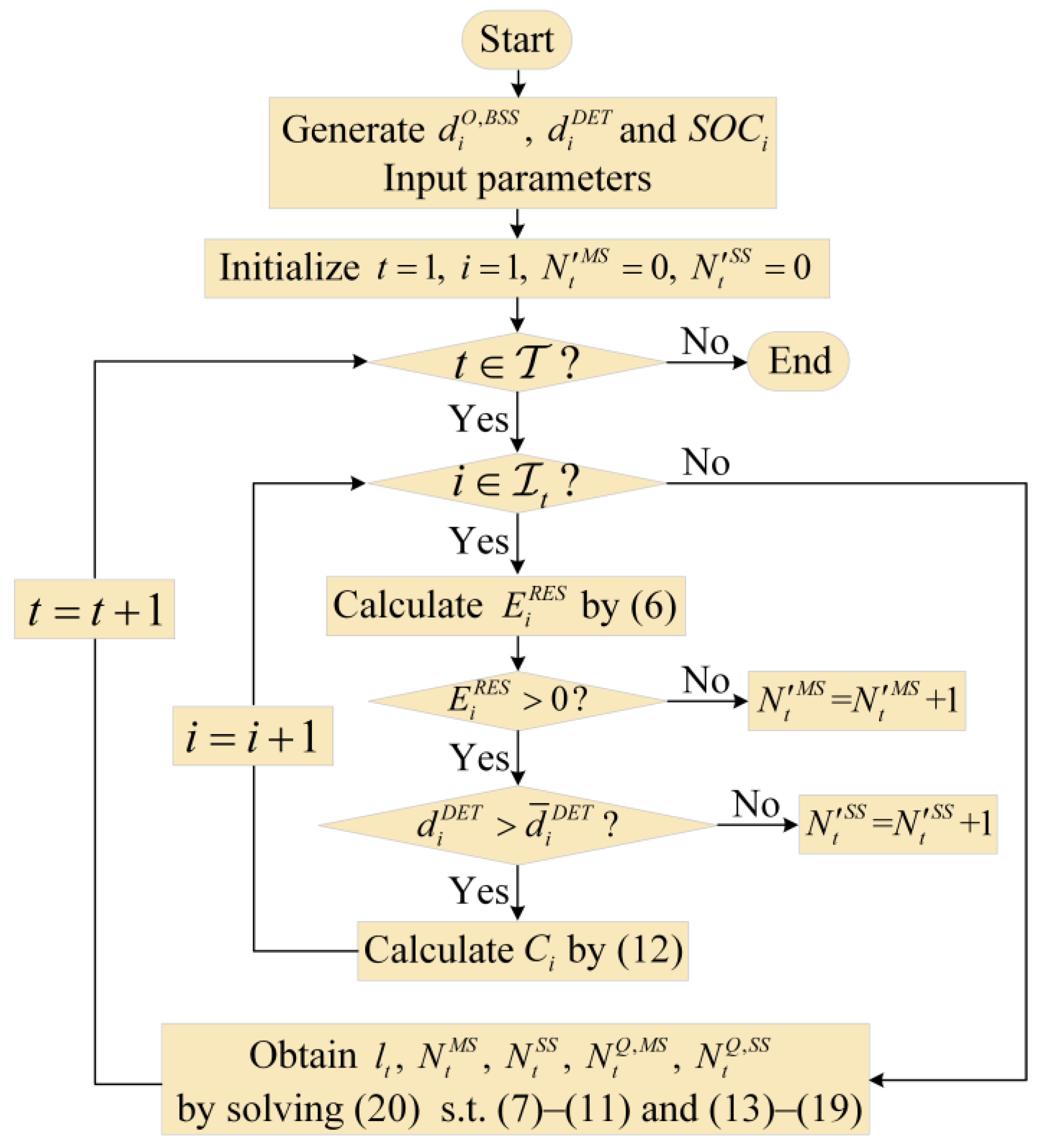
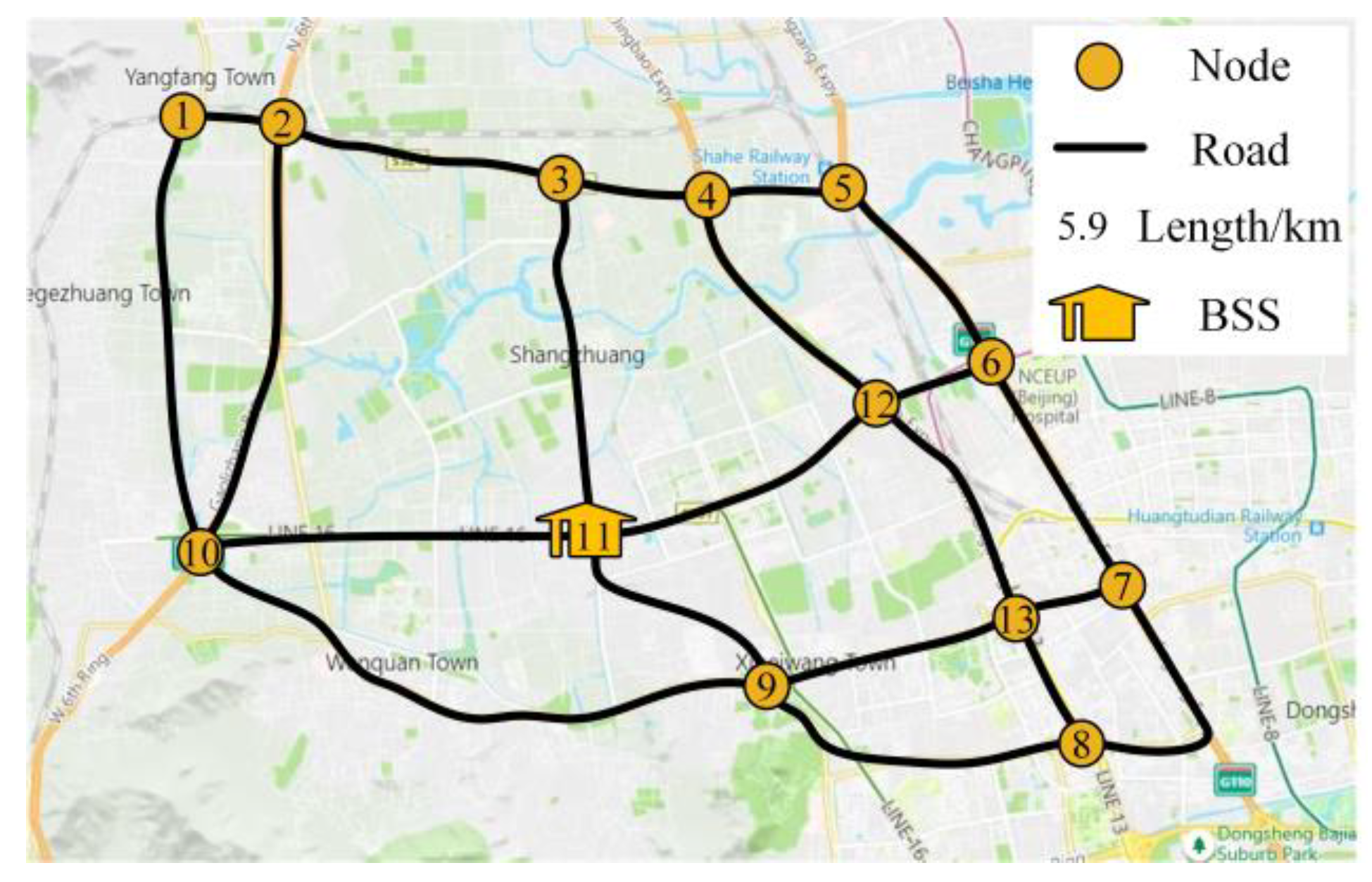
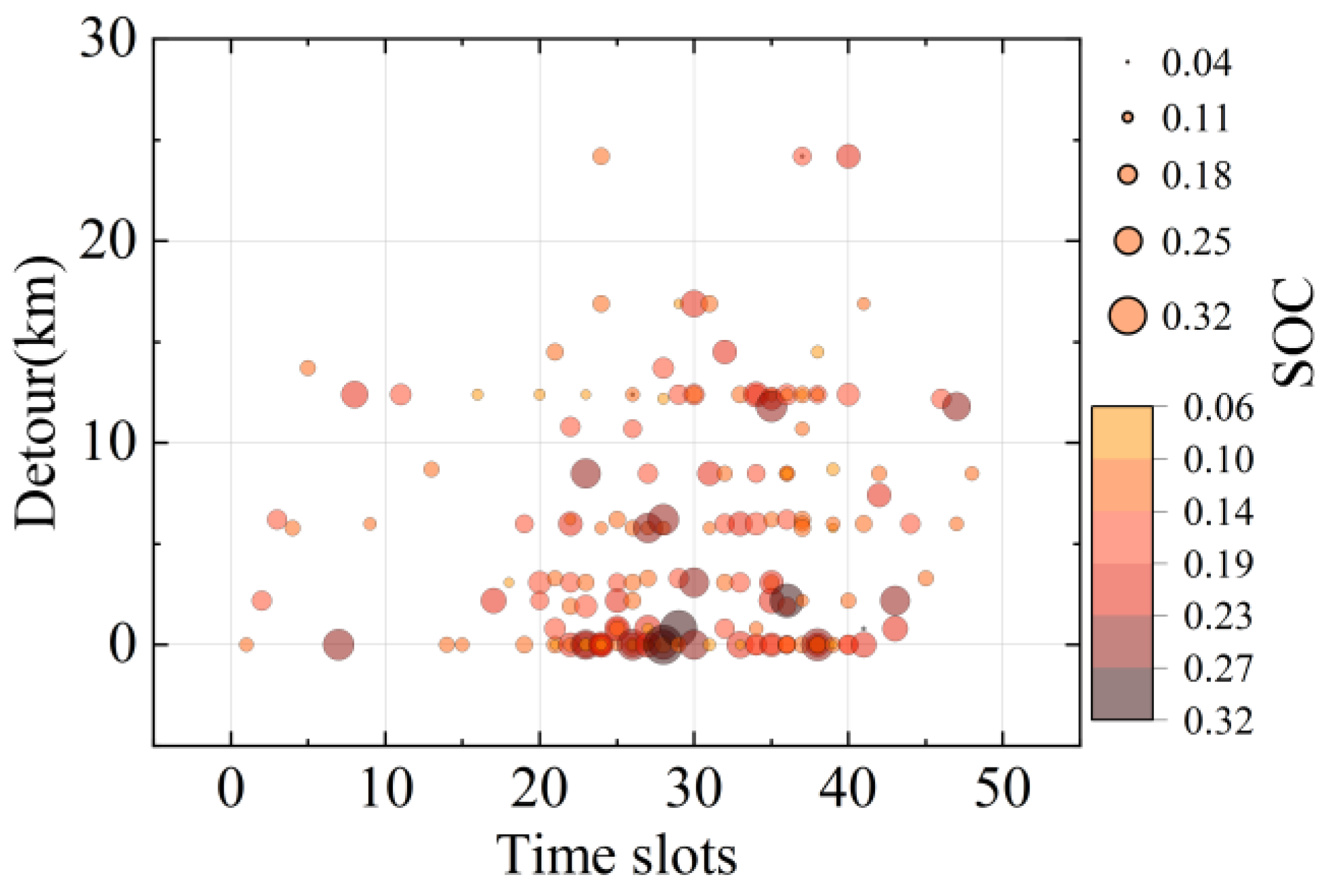


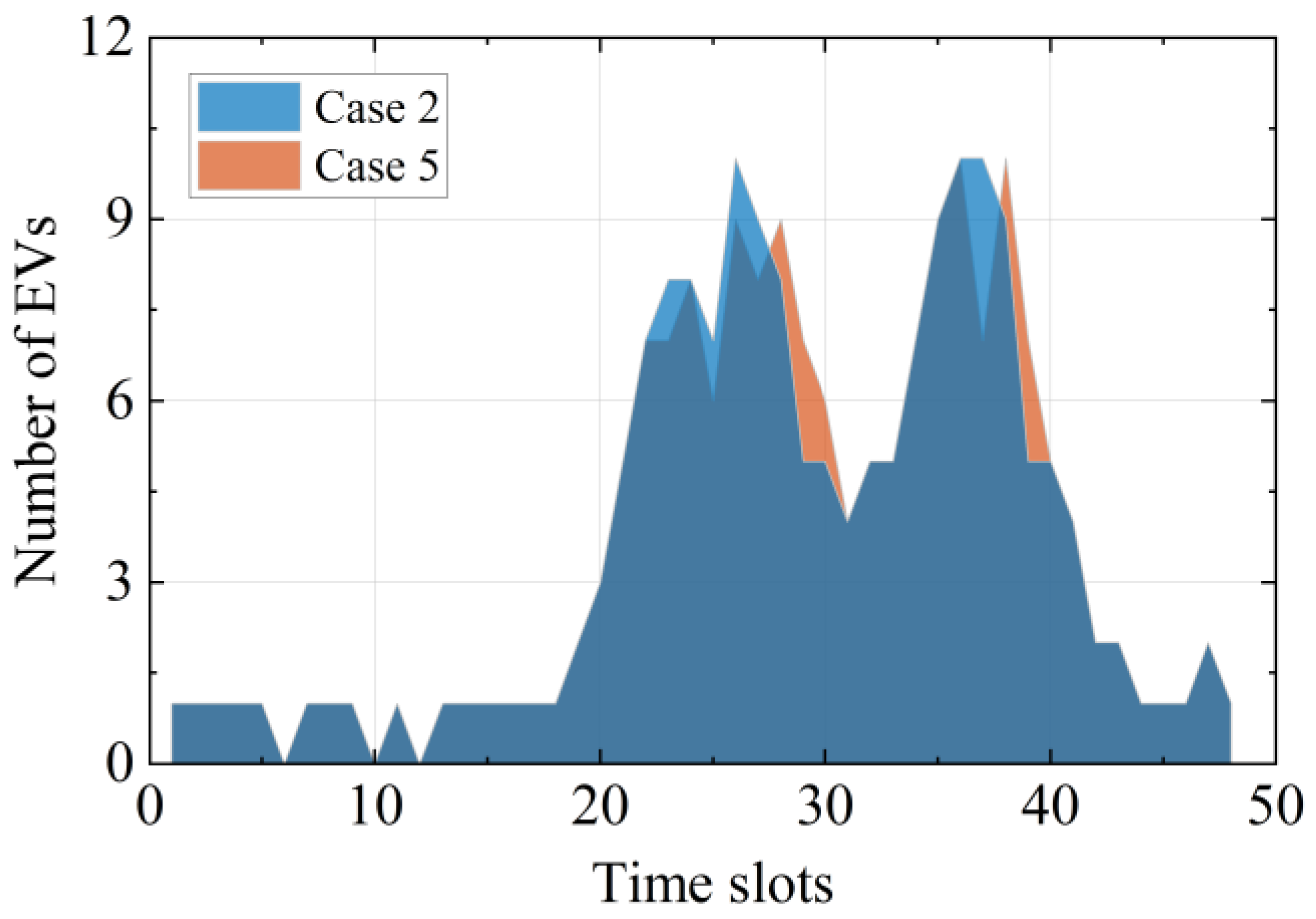
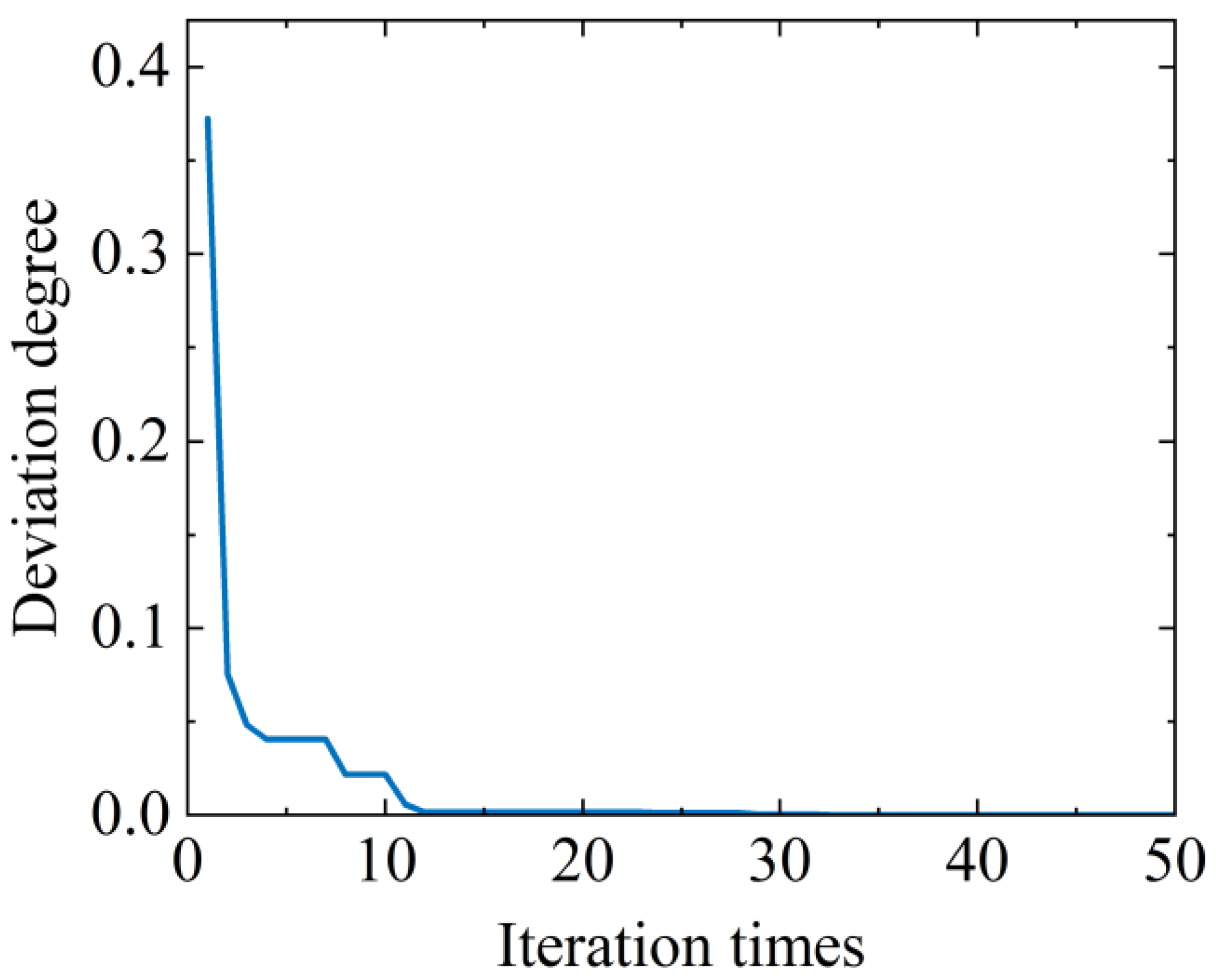
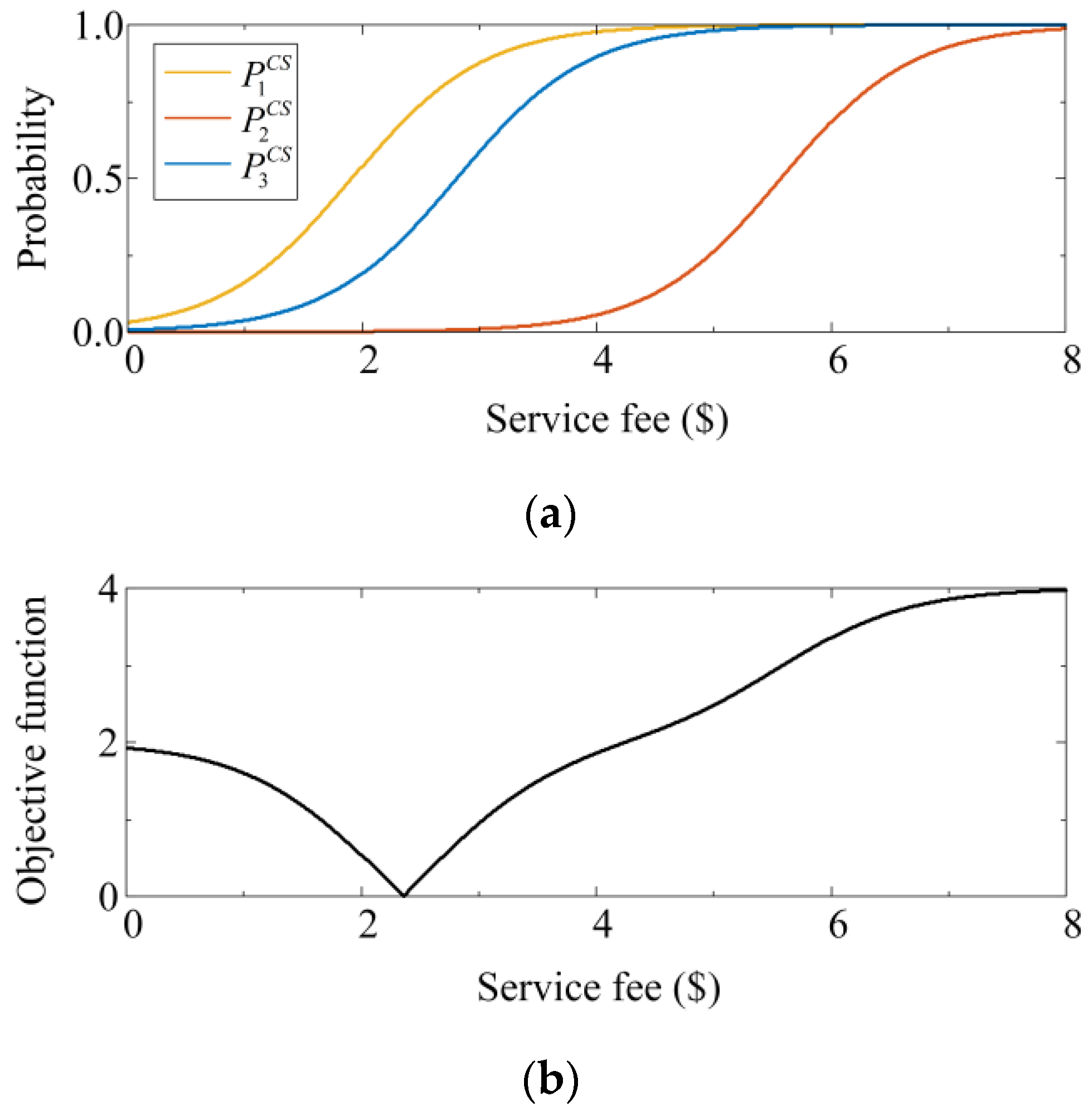
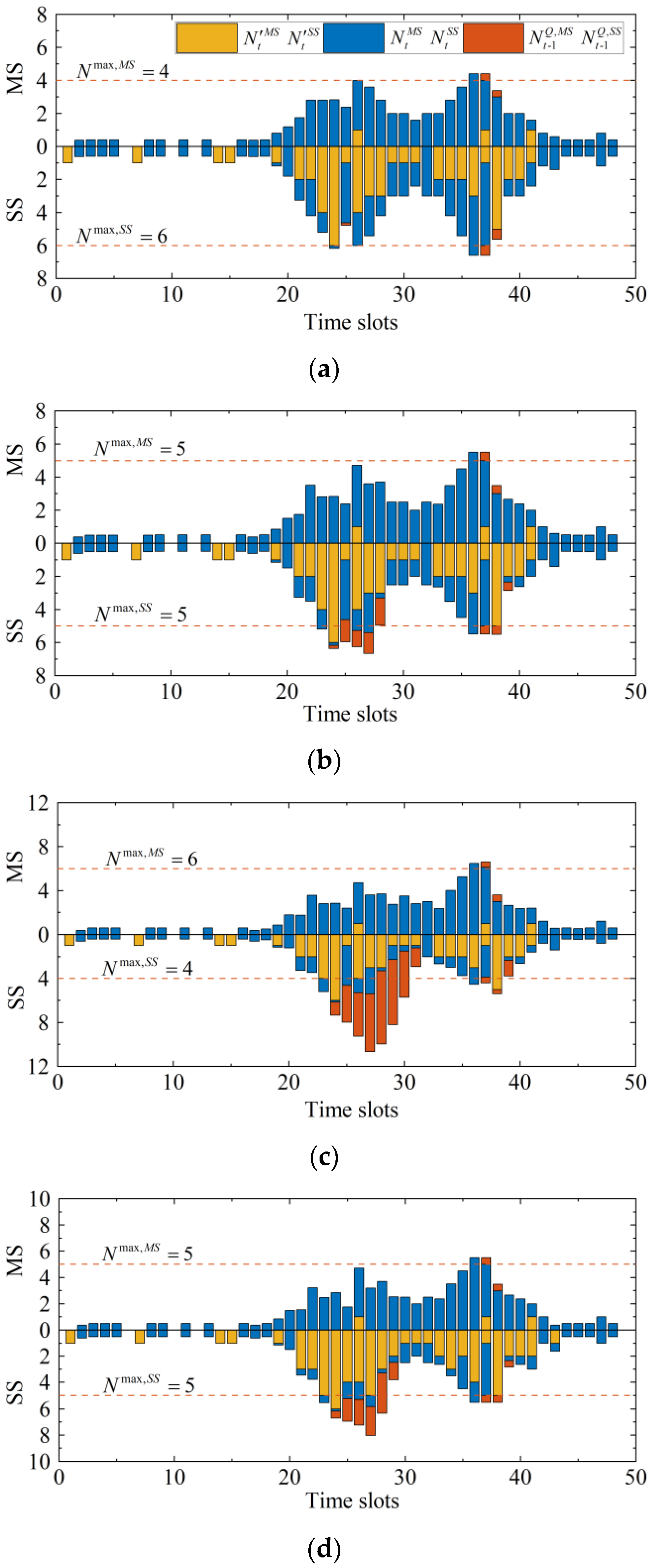
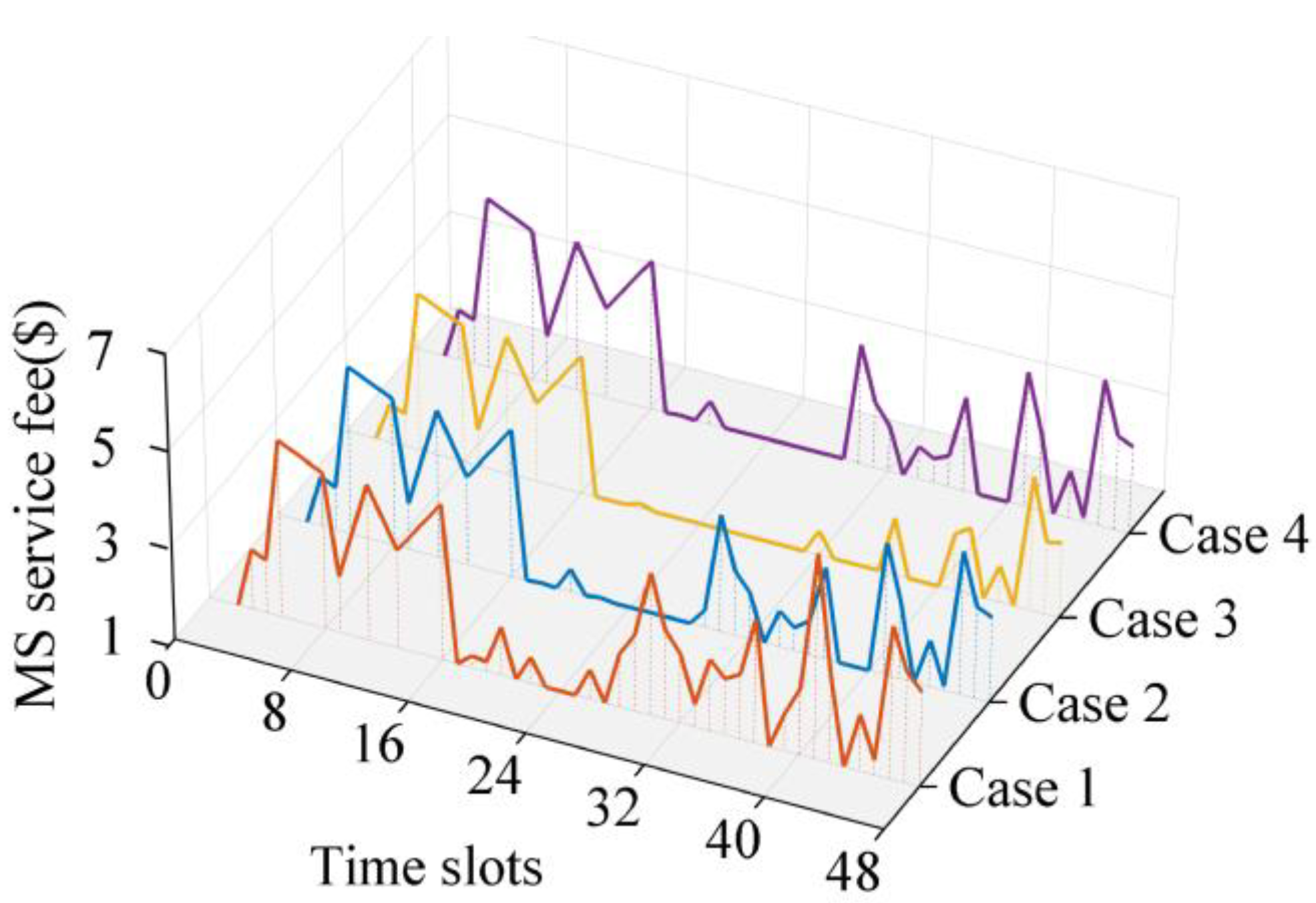
| Parameter | |||||||
|---|---|---|---|---|---|---|---|
| Value | 0.15 | 0.2 | 1.8 | 62(kWh) 1 | 3 2 | 3 2 | 1(USD) |
| Case | /km | Service Fee | ||
|---|---|---|---|---|
| 1 | 4 | 6 | 0 | Optimal |
| 2 | 5 | 5 | 0 | Optimal |
| 3 | 6 | 4 | 0 | Optimal |
| 4 | 5 | 5 | 2 | Optimal |
| 5 | 5 | 5 | 0 | Constant |
| Case | Queue length | Active Selection | Average /USD | |||
|---|---|---|---|---|---|---|
| Total | MS | SS | MS | SS | ||
| 2 | 7.93 | 1 | 6.93 | 74.89 | 44.11 | 1.96 |
| 5 | 27.96 | 2.64 | 25.32 | 72.12 | 46.88 | 1.81 |
| Case | Queue Length | Active Selection | Average /USD | |||
|---|---|---|---|---|---|---|
| Total | MS | SS | MS | SS | ||
| 1 | 2.16 | 0.8 | 1.36 | 63.12 | 55.88 | 2.37 |
| 2 | 7.93 | 1 | 6.93 | 74.89 | 44.11 | 1.96 |
| 3 | 35.7 | 1.07 | 34.63 | 83.11 | 35.89 | 1.65 |
| 4 | 13.28 | 1 | 12.28 | 72.83 | 33.17 | 1.95 |
Disclaimer/Publisher’s Note: The statements, opinions and data contained in all publications are solely those of the individual author(s) and contributor(s) and not of MDPI and/or the editor(s). MDPI and/or the editor(s) disclaim responsibility for any injury to people or property resulting from any ideas, methods, instructions or products referred to in the content. |
© 2023 by the authors. Licensee MDPI, Basel, Switzerland. This article is an open access article distributed under the terms and conditions of the Creative Commons Attribution (CC BY) license (https://creativecommons.org/licenses/by/4.0/).
Share and Cite
Wang, Z.; Hou, S. Optimal Scheduling for Hybrid Battery Swapping System of Electric Vehicles. Processes 2023, 11, 1604. https://doi.org/10.3390/pr11061604
Wang Z, Hou S. Optimal Scheduling for Hybrid Battery Swapping System of Electric Vehicles. Processes. 2023; 11(6):1604. https://doi.org/10.3390/pr11061604
Chicago/Turabian StyleWang, Ziqi, and Sizu Hou. 2023. "Optimal Scheduling for Hybrid Battery Swapping System of Electric Vehicles" Processes 11, no. 6: 1604. https://doi.org/10.3390/pr11061604
APA StyleWang, Z., & Hou, S. (2023). Optimal Scheduling for Hybrid Battery Swapping System of Electric Vehicles. Processes, 11(6), 1604. https://doi.org/10.3390/pr11061604





